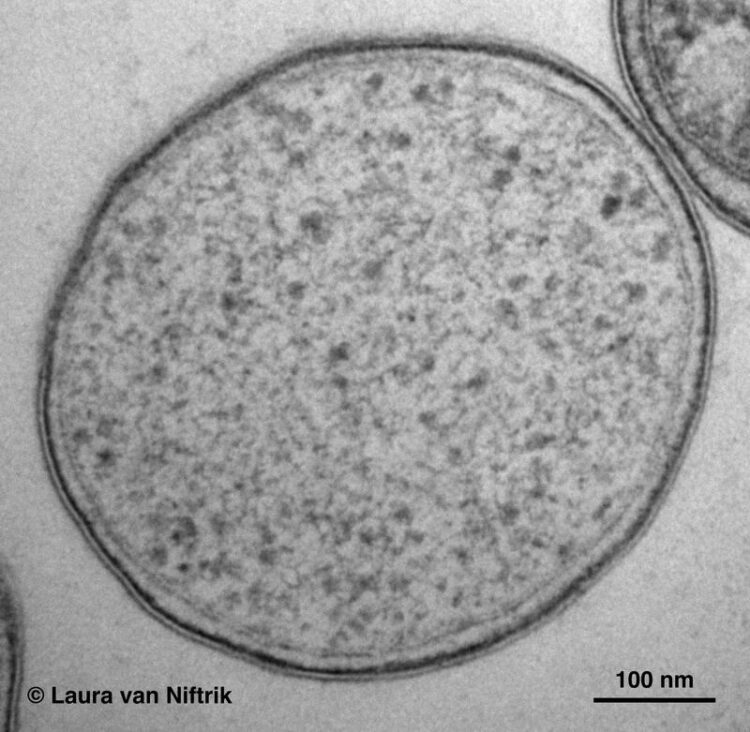When methane-eating microbes eat ammonia instead

Inconspicuous, but still very remarkable: A Methylacidiphilum fumariolicum cell under the electron microscope.
Laura van Niftrik
As a side effect of their metabolism, microorganisms living on methane can also convert ammonia. In the process, they produce nitric oxide (NO), a central molecule in the global nitrogen cycle. Scientists from the Max Planck Institute for Marine Microbiology, Bremen (DE), and Radboud University, Nijmegen (NL), now discovered the enzyme that produces NO, closing an important gap in our understanding of how methanotrophs deal with rising environmental ammonia concentrations.
Some microorganisms, the so-called methanotrophs, make a living by oxidizing methane (CH4) to carbon dioxide (CO2). Ammonia (NH3) is structurally very similar to methane, thus methanotrophs also co-metabolize ammonia and produce nitrite. While this process was observed in cell cultures, the underlying biochemical mechanism was not understood. Boran Kartal, head of the Microbial Physiology Group at the Max Planck Institute for Marine Microbiology in Bremen, Germany, and a group of scientists from Radboud University in Nijmegen, The Netherlands, now shed light on an exciting missing link in the process: the production of nitric oxide (NO).
Nitric oxide is a highly reactive and toxic molecule with fascinating and versatile roles in biology and atmospheric chemistry. It is a signaling molecule, the precursor of the potent greenhouse gas nitrous oxide (N2O), depletes the ozone layer in our atmosphere, and a key intermediate in the global nitrogen cycle.
It now turns out that NO is also the key for the survival of methanotrophs that face ammonia in the environment – which they do more and more as fertilizer input into nature increases. When methanotrophs co-metabolize ammonia they initially produce hydroxylamine, which inhibits other important metabolic processes, resulting in cell death. Thus, methanotrophs need to get rid of hydroxylamine as fast as possible. “Carrying a hydroxylamine-converting enzyme is a matter of life or death for methane-eating microbes”, Kartal says.
For their study, Kartal and his colleagues used a methanotrophic bacterium named Methylacidiphilum fumariolicum, which originates from a volcanic mud pot, characterized by high temperatures and low pH, in the vicinity of Mount Vesuvius in Italy. “From this microbe, we purified a hydroxylamine oxidoreductase (mHAO) enzyme,“ reports Kartal. “Previously it was believed that mHAO enzyme would oxidize hydroxylamine to nitrite in methanotrophs. We now showed that it actually rapidly produces NO.
” The mHAO enzyme is very similar to the one used by “actual” ammonia oxidizers, which is quite astonishing, as Kartal explains: “It is now clear that enzymatically there is not much difference between aerobic ammonia- and methane-oxidizing bacteria. Using essentially the same set of enzymes, methanotrophs can act as de facto ammonia oxidizers in the environment. Still, how these microbes oxidize NO further to nitrite remains unknown.”
The adaptation of the mHAO enzyme to the hot volcanic mud pots is also intriguing, Kartal believes: “At the amino acid level, the mHAO and its counterpart from ammonia oxidizers are very similar, but the protein we isolated from M. fumariolicum thrives at temperatures up to 80 °C, almost 30 °C above the temperature optimum of their “actual” ammonia-oxidizing relatives. Understanding how so similar enzymes have such different temperature optima and range will be very interesting to investigate.”
According to Kartal, production of NO from ammonia has further implications for methane-eating microbes: “Currently there are no known methanotrophs that can make a living out of ammonia oxidation to nitrite via NO, but there could be methanotrophs out there that found a way to connect ammonia conversion to cell growth.”
Wissenschaftliche Ansprechpartner:
Dr. Boran Kartal
Head of the Microbial Physiology Group
Max Planck Institute for Marine Microbiology, Bremen, Germany
Phone: +49 421 2028-645
E-Mail: bkartal@mpi-bremen.de
Dr. Fanni Aspetsberger
Head of Press and Communications
Max Planck Institute for Marine Microbiology, Bremen, Germany
Phone: +49 421 2028-947
E-Mail: faspetsb@mpi-bremen.de
Originalpublikation:
Wouter Versantvoort, Arjan Pol, Mike S. M. Jetten, Laura van Niftrik, Joachim Reimann, Boran Kartal, and Huub J. M. Op den Camp: Multiheme hydroxylamine oxidoreductases produce NO during ammonia oxidation in methanotrophs. PNAS. September 2020.
DOI: 10.1073/pnas.2011299117
Weitere Informationen:
Media Contact
All latest news from the category: Life Sciences and Chemistry
Articles and reports from the Life Sciences and chemistry area deal with applied and basic research into modern biology, chemistry and human medicine.
Valuable information can be found on a range of life sciences fields including bacteriology, biochemistry, bionics, bioinformatics, biophysics, biotechnology, genetics, geobotany, human biology, marine biology, microbiology, molecular biology, cellular biology, zoology, bioinorganic chemistry, microchemistry and environmental chemistry.
Newest articles

An Endless Loop: How Some Bacteria Evolve Along With the Seasons
The longest natural metagenome time series ever collected, with microbes, reveals a startling evolutionary pattern on repeat. A Microbial “Groundhog Year” in Lake Mendota Like Bill Murray in the movie…

Witness Groundbreaking Research on Achilles Tendon Recovery
Achilles tendon injuries are common but challenging to monitor during recovery due to the limitations of current imaging techniques. Researchers, led by Associate Professor Zeng Nan from the International Graduate…

Why Prevention Is Better Than Cure—A Novel Approach to Infectious Disease Outbreaks
Researchers have come up with a new way to identify more infectious variants of viruses or bacteria that start spreading in humans – including those causing flu, COVID, whooping cough…



